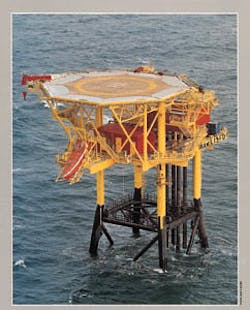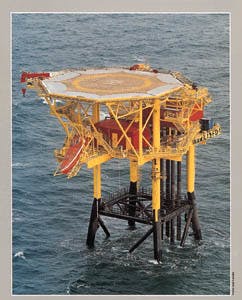Diverse FPSO flotilla encourages analysis review
Neil Potter
Contributing Editor
Freefall lifeboat arrangement for a NAM satellite platform.The fleet of floating production systems is steadily increasing worldwide, whether monohull or semisubmersible, in steel or concrete, newbuilds or conversions.
In many instances, they have in fact become the first choice for field development. Developments in mooring and tethers and in turret and swivel technology have advanced so much that today, uptime of virtually 100% is being achieved on North Sea fields.
Some sceptics wondered about the safety aspects of the earlier versions, particularly if they were tanker conversions. But safety is and always will be a key factor in the design and construction of floaters.
Britain's Health & Safety Executive (HSE) has said that deepwater developments such as those west of Shetland present new challenges to mechanical systems design. Failure of systems on the typical ship-shaped, turret-moored vessels could lead to serious hazards to the vessel and crew. Therefore, assessment of best practices for mechanical swivels and large diameter slewing rings is required and is a key part of HSE's R&D program.
Design guide
This year has brought publication, following five years' work, of an 1,100 page guide to assist design and analysis of floating structures, also aimed at raising standards. This project, organized by Britain's Marine Technology Directorate, was sponsored by 25 companies with some individual chapters written by technical services contractors.
The design safety case for the newbuild Anasuria, for Shell Expro's Teal/Guillemot development, was one of the first to be accepted by HSE late in 1994, and certainly the first for an FPSO. The operational safety case was accepted in mid-1996.
SBM, which had overall responsibility for the unit, awarded a lump sum contract to Stork Protech for the design and supply of the topsides. Safety, it was stressed, was the underlying factor and Shell wanted a minimum of personnel onboard. Two alternatives were considered for the location of the living quarters - either at the bow of the vessel in front of the turret or at the stern. Safety and environmental studies were initiated early in the design development.
The two main contributors to overall risk are hydrocarbon fire and explosion (36%) and helicopter transfer (24%). Of the hydrocarbon risk component, more than half (56%) is borne by the potential for a riser failure.
Greater separation of the living quarters and associated evacuation facilities from the manifold/riser area and greater crew comfort due to less motion contributed to the final choice of positioning the accommodation at the stern.
The quarters are designed as the temporary refuge and are separated from the production facilities by 80 metres and from the utilities by 40m. Another safety feature is that on both sides of the main deck, covered escape routes run from the bow to the accommodation area, with intermediate access from the process deck.
Conoco has decided to use a new FPSO design for its central North Sea Banff development, supplied by PGS. This has raised some eyebrows, as it will be the first application of the Ramform delta-shaped design, hitherto used for seismic vessels, for production. The unit will be operated by Atlantic Power.
Conoco says the Ramform offers superior stability and deckload capacity. The vessel's triangular shape results in natural weathervaning, a safety advantage that will always keep the temporary safe refuge on the vessel upwind of any fire and smoke.
The Ramform is based on a patented design by the Norwegian naval architect Roar Ramde. PGS says his design criteria for the floater were first and foremost the safety of crew, cargo and the structure itself.
With accommodation, helideck, engine, control rooms main firefighting and life-saving equipment in front of the turret, the entire area behind the blast wall is available for the process equipment.
Close liaison is being maintained with HSE at this stage, prior to submitting the design safety case. Dave Workman of Atlantic Floating Production (Atlantic Power) says no major problems have arisen.
Tank tests have been successfully performed at the Maritime Dynamics Laboratory in Sweden, and further tank tests are continuing prior to the cutting of first steel for the hull at the Hyundai yard at Ulsan, South Korea.
The vessel is 380 ft long compared with the more normal 700 ft and has a 175 ft beam, giving it a deck load carrying capacity of 16,000 tons. PGS says it has extremely good motion characteristics. One of the Ramform seismic vessels continued operations west of Shetland through 48 hours of force 7-8 winds with gusts up to force 10 and seas of 13 ft-plus from the beam.
The Ramform, says PGS, has to sustain extensive structural damage before it reaches a stage where it is in danger of capsizing. Model tests and operational reports from the seismic vessels confirm that green seas will never sweep the decks and will never cause structural damage to the superstructure or topsides equipment.
Laminaria, Terra Nova FPSOs new role for Lloyds Register
Lloyds Register, which previously played a role as an offshore installation certification society, is now playing a key verification part, particularly with FPSOs where its long-respected marine classification rules are of integral importance.George Alfred, Head of Ocean Engineering at LR, explains: "Safety is a line responsibility and the operator has to set out a strategy approach to safety requirements which cater for the technical integrity of the development for the project life cycle. While the FPSO market is flourishing, the focus on reduced development time has emphasized the importance of value-adding services which provide operators with independent judgment from the pre-conceptual phase of the project in order to ensure safety and quality for the life cycle of the development.
"The Concept Design Evaluation, developed by LR, is specifically tailored to assist project teams to verify that the chosen concept will result in an acceptable installation, and that no major design changes with associated cost penalties will be incurred due to unforeseen safety or legislative requirements."
LR's two latest FPSO contracts are for Laminaria in the Timor Sea and Terra Nova off Newfoundland, both newbuilds. Sea and icebergs are among the major challenges to be faced on Terra Nova, for which a consortium is designing and building a steel monohull FPSO.
The combination of low air and water temperatures with wind and wave actions makes superstructure icing a consideration during the winter months. An allowance of several hundred tonnes of superstructure ice accumulation has to be factored into weight and stability calculations. Ice management will play a key role in field management.
Aluminium lifeboats stand by on further Dutch sector platforms
L9-FF-1, the Dutch sector's largest new accommodation and gas production platform, will feature an aluminium freefall lifeboat system from Verhoef. The Aalsmeer, Netherlands-based company is the world's only manufacturer of such systems.For this installation, NAM commissioned an FL 50 type lifeboat which can carry up to 45 people. Last year, NAM ordered a lighter FL 25 type, 16-person lifeboat from Verhoef for its new K14-FB-1 gas platform. The boats weigh 7,125kg and 4,200kg respectively. To date NAM has installed 213 such lifeboats on its offshore installations, more than any other North Sea operator.
The FL 50 is the most robust aluminium type currently available. Others were bought by Maersk in Denmark recently for its Harald, Skjold and Dan developments and by Elf Petroland in The Netherlands for its new K6 and K5 gas platforms. Verhoef boats will also feature on Elf's new Elgin Field production installation in the UK sector in 1999.
These orders follow extensive R & D by Verhoed aided by various technology institutes in The Netherlands and elsewhere. The programme included fire tests during which an aluminium freefall lifeboat was placed in a tank filled with water and 4,000 litres of kerosene which burned for at least 10 minutes at an outside temperature of 1,200degC. Air analysis was performed every 30 seconds but no noxious gases were detected. Some soot marks on the hull following the test were the only indications that the boat had been in a fire. The average temperature inside the boat did not exceed 30degC.
"We have put a lot of effort into improving the boat's stability and the positioning of the aluminium seats," says Verhoef vice-president Martin Verhoef. "The lifeboats can now be boarded significantly faster.
"The actual design of the boat was standardised after the Piper Alpha disaster when we supplied a new generation of freefall lifeboats for Piper Bravo. The operators urged us to make the boats cheaper, which we did through use of innovative materials and new, more efficient fabrication procedures."
Copyright 1997 Oil & Gas Journal. All Rights Reserved.

